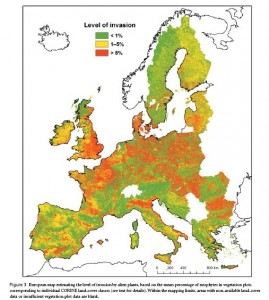- Mathilda on domestication of the vine and donkey.
- New software for species mapping is out: Croziat.
- Another day, another tuber.
- Using Diversity as a Pest Management Tool. There’s a thought.
- Pix of West African plants, including cultivated, with lots of assorted link goodness.
Nibbles: Cotton, Citrus, Fig, Permaculture, Turtles, Wine, Cacao, Fish
- Wild cotton use lands prize for boffin trio.
- Unesco to protect wild Citrus in India. And read the discussion.
- IV International Symposium on Fig.
- Permaculture: The Podcast.
- The NY Times thinks Americans should eat fewer turtles. And drink more South African wine.
- Meanwile, the WSJ gets into single-source chocolate.
- Nice map of freshwater fish diversity. But will it last? WWF has a plan.
Army worms on the march
I think I may have blogged before about the ProMED-mail “global electronic reporting system for outbreaks of emerging infectious diseases & toxins.” You can get email alerts and also produce maps for plant diseases, such as this one:

Unfortunately, the system only covers infectious diseases. It is a programme of the International Society for Infectious Diseases, after all. Otherwise, it would have picked up the plague of armyworms currently affecting Liberia. A quick search of my feed reader revealed outbreaks in Namibia and Zimbabwe within the past two years. And Google Trends shows some interesting, ahem, trends in searching News archives show this timeline for news of this pest ((The search expression was: (armyworm OR “army worm”) AND outbreak.)) over the past few years:

There’s research on natural enemies going on, but that’s not going to help Liberia right now.
Europe invaded by aliens
The journal Diversity and Distribution has a paper on the distribution of alien plants in Europe. You need a subscription for that, but the paper also appears to be online here, on the website of one of the authors. Here’s the map (click to enlarge it):

Could this be used to estimate the level of threat faced by some crop wild relatives?
Tomato diversity in Google Earth
Here’s a fun thing. There’s a group pool on Flickr, the photo sharing site, called “tomatoes!” ((And also similar pools for lots of other plants.)) All kinds of pictures of all kinds of tomatoes, and very beautiful is all that diversity to look at too. But you can do more. Like for example map where the photos were taken (assuming the photographer uploaded a georeference). Which could give you a snapshot of where tomatoes are grown or consumed — or maybe just particularly loved. You can also generate a kml file. Here’s what you get when you view it in Google Earth:

Haven’t quite worked it out. This doesn’t seem to be all the georeferenced tomato photos from Europe in the group. Maybe just the latest to be uploaded. But I can’t help thinking this is a great way of displaying the geographic distribution of agricultural biodiversity.